
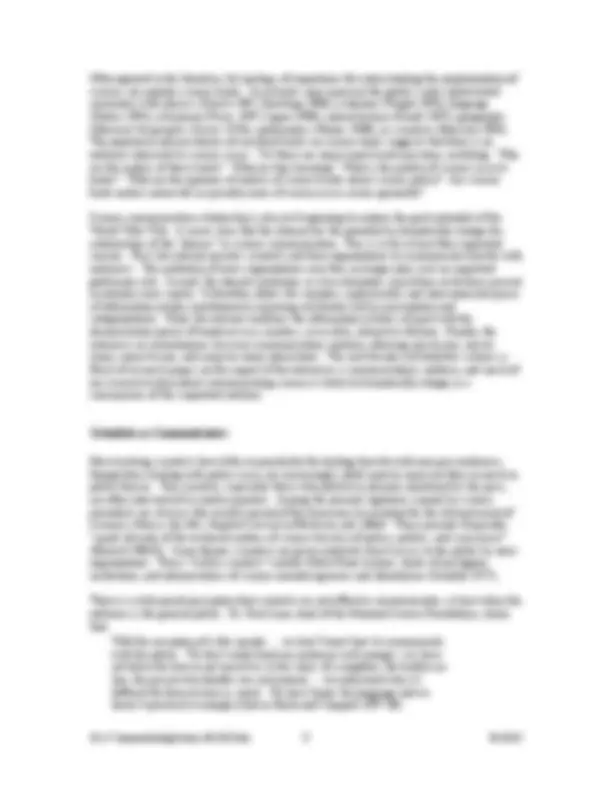
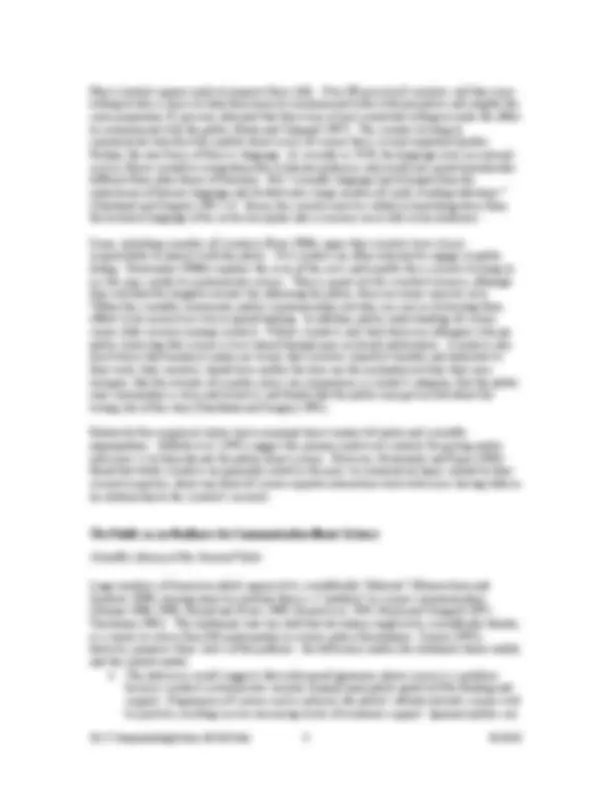
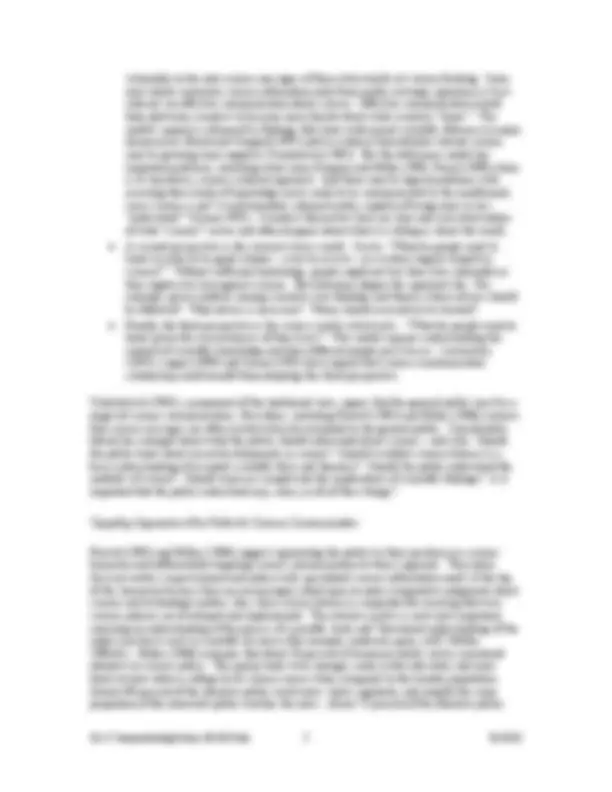
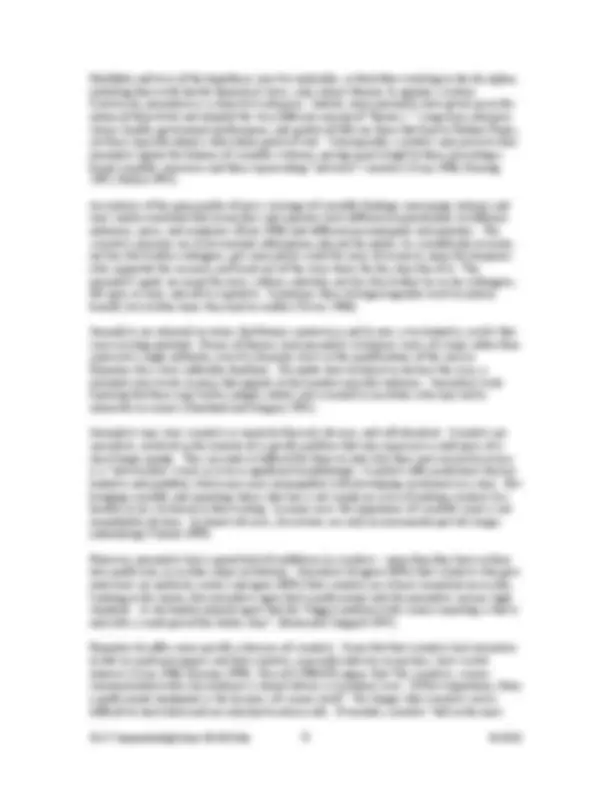
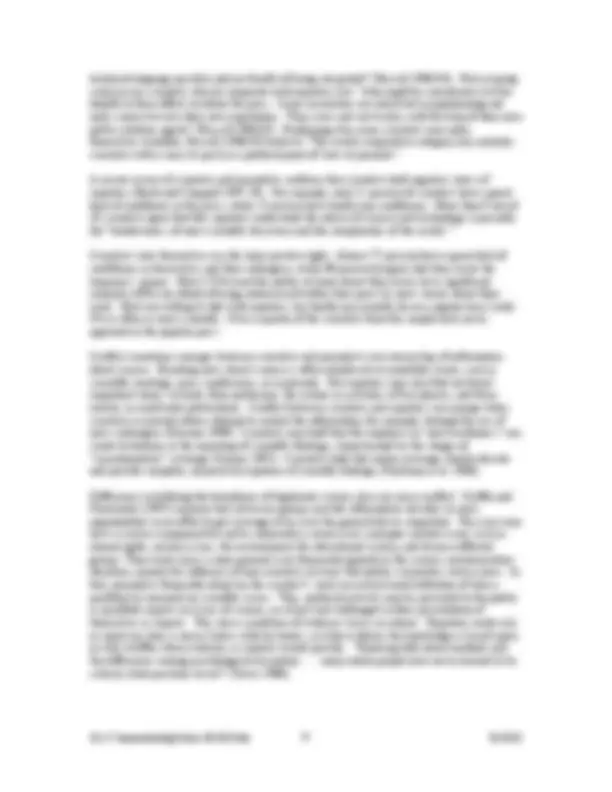
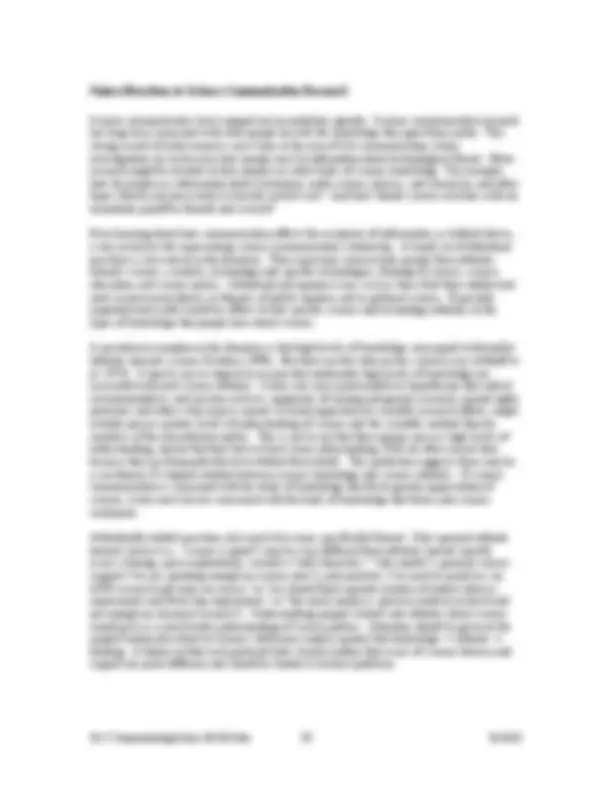
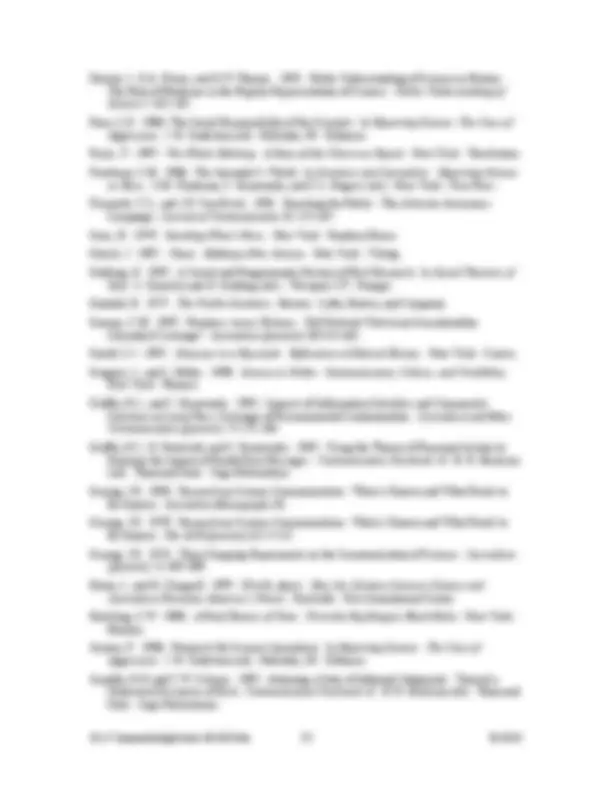
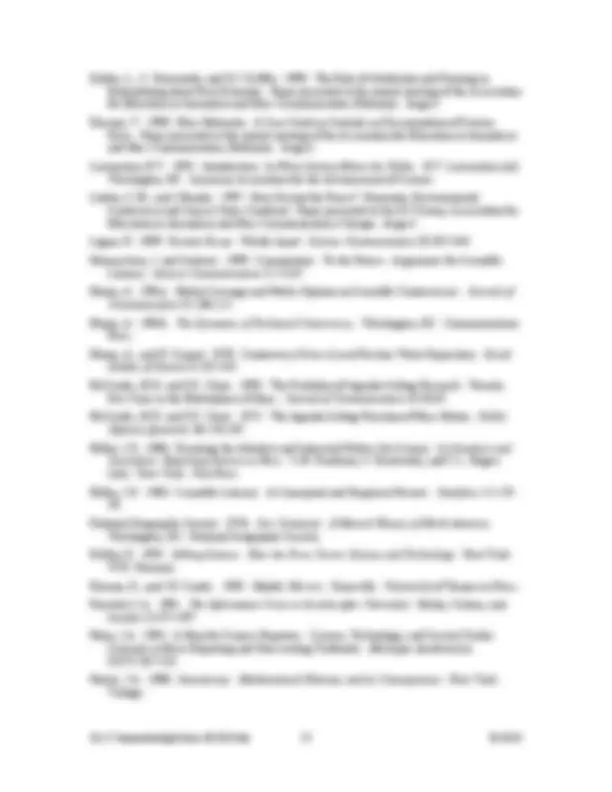
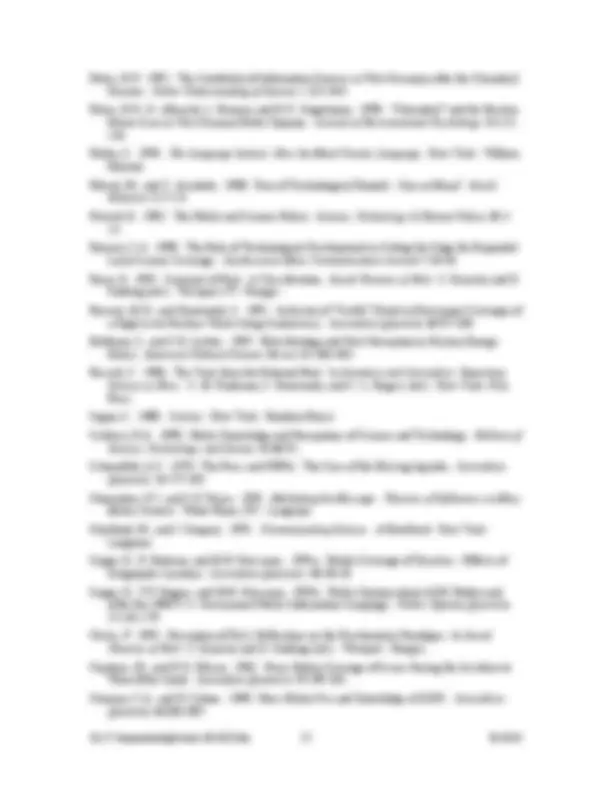


Study with the several resources on Docsity

Earn points by helping other students or get them with a premium plan


Prepare for your exams
Study with the several resources on Docsity

Earn points to download
Earn points by helping other students or get them with a premium plan
Community
Ask the community for help and clear up your study doubts
Discover the best universities in your country according to Docsity users
Free resources
Download our free guides on studying techniques, anxiety management strategies, and thesis advice from Docsity tutors
Management Benchmark Study-Book Summary Chapter 17-Literature-Elizabeth L. Malone Communicating Science, Michael Weigold, Media Coverage of Science, Scientists as Communicators, Interactions Between Scientists and Journalists, Application of Science Communication to Public Science Management
Typology: Summaries
1 / 16

This page cannot be seen from the preview
Don't miss anything!










Media messages about science have long attracted attention from communication scholars (Cronholm and Sandell 1981; Grunig 1979, 1983; Jerome 1986; Lewenstein 1992). Perhaps this is surprising, since the attention given science in most news media is small in comparison to that accorded to business, politics, or even sports and entertainment. But scholars in this area argue that the importance of science news is poorly benchmarked by the attention it receives in most mass media. In an era of unprecedented technological and scientific advances, many of which have the potential to radically change human existence, science news is important.
Communicating about science and the scientific enterprise is an important responsibility of public science organizations. Although many organizations have communication specialists to help with this responsibility, managers are frequently called upon to decide what information is to be provided to whom, by whom, and in what form. Indeed, they are often called upon to be spokespersons for their organizations. Yet they are often unprepared to meet journalists’ demands for non-technical language, conciseness, and short deadlines. Much science news does not get covered in the mainstream press and may not reach science-interested audiences.
News media have historically accorded science great importance. In the 19th^ century, newspapers reprinted lectures of Thomas Huxley, Louis Agassiz and Asa Gray, and one issue of the New York Tribune published the text of physics lectures by John Tyndall. During the 1920s press magnate Edwin W. Scripps launched the Science Service, a news agency offering the “drama [that] lurks in every test tube.” Science coverage may have reached its zenith during the Second World War, when science and technology were seen as integral to victory (Shortland and Gregory 1991). The launching of Sputnik led to a reevaluation of science education in the United States and to renewed interest in science generally.
Modern news organizations are more likely to view science as a “niche” area. Thus, in larger news organizations science may be covered by a beat reporter while in smaller organizations reporting is more typically handled by a general assignment reporter or through the use of wire services (Friedman 1986). The medium also affects the quality and amount of science news. Most in-depth reporting is done by newsmagazines, followed by large national papers. Wires, small dailies, and broadcast stations are least likely to have the time or money for in-depth science coverage (Ward 1992). Science news competes with other kinds of news for a relatively tiny amount of space/time. Friedman (1986) estimates that perhaps five percent of a typical newspaper is reserved for news of the day. Most papers thus place heavy emphasis on story brevity and simplicity. Coverage of issues in broadcast reports is even tighter. Because audiences for science stories often require considerable background information, science writers face a difficult challenge.
(^1) Related chapters include: Strategy; Alliances, Partnerships, and Networks; Participative Management and
Employee and Stakeholder Involvement; Organizational Culture; Organizational Communication. (^2) Associate Professor, Department of Advertising, University of Florida
Several researchers have raised the “gatekeeping” question: how does news from the environment, including news about science, pass through the editorial gate to become content? Shoemaker and Reese (1991) suggest that all news organizations rely on the following “craft norms” for generating news:
Research has confirmed that these criteria are relevant for a newspaper’s decision about science coverage (Singer et al. 1991a; Ramsey 1989).
Other constraints that influence news selection include the complexity of deadlines, unpredictability of occurrences, and the organization's ability to adapt to physical limits, including limits of time and space (Liebler and Bendix 1997). Reporters rely on routines that provide access to news, such as press conferences, announcements, and scientific meetings. Because of limits of time and resources, reporters often work from “predefined angles” or frames that provide themes around which to build stories (Baker 1986; Shoemaker and Reese 1991). News organizations also rely heavily upon each other for ideas. Gans (1979) argued that editors read elite media such as the New York Times and Washington Post for story ideas, eliminating the need for an independent judgment of newsworthiness, a function described by media scholars as “inter-media” agenda setting (Shoemaker and Reese 1991). This was supported by Breed’s (1980) findings that editors of smaller papers use larger city papers to guide them.
Modern coverage of science varies considerably within and across media. Larger newspapers with more resources and better educated readers, such as the New York Times , “will cater to an audience interested in reading about some advances in science or medicine that will be ignored by the editors of the New York Daily News” (Burkett 1986:12). Newspapers that carry regular science sections also give greater coverage to science in the news section of the paper in comparison to papers without science coverage (Bader 1990). This is especially the case for stories about basic research rather than more applied topics. Magazine writers draw upon images of their audiences even more narrowly, although even within newsweeklies there is variation; for example, Time uses more scientific terms without translation than Newsweek (Burkett 1986). TV news, with its small news hole, often squeezes coverage of science to its bare minimum (Altheide 1976).
Specialty magazines offer some of the richest and most sophisticated coverage of science for general audiences. S cientific American employs editors, but it is scientists, not reporters, who write the stories. Less-knowledgeable readers who might have difficulty with Scientific American can still satisfy their curiosity with "popularized" magazines such as Science Digest , Discover , Omni , and Popular Science (Burkett 1986).
Most scientists appear ready to improve their skills. Over 80 percent of scientists said they were willing to take a course to help them learn to communicate better with journalists and roughly the same proportion, 81 percent, indicated that they were at least somewhat willing to make the effort to communicate with the public (Hartz and Chappell 1997). The scientist wishing to communicate directly with a public about issues of science faces several important hurdles. Perhaps the most basic of these is language. As recently as 1920, the language used in a journal such as Nature would be comprehensible to literate audiences and would not sound dramatically different from other forms of literature. But “scientific language had diverged from the mainstream of literary language and divided into a large number of small, winding tributaries” (Shortland and Gregory 1991:12). Hence the scientist must be skilled at translating ideas from the technical language of his or her discipline into a currency accessible to lay audiences.
Some, including a number of scientists (Eron 1986), argue that scientists have a basic responsibility to interact with the public. Yet scientists are often reluctant to engage in public dialog. Dunwoody (1986b) explores the issue of the costs and benefits for a scientist wishing to use the mass media to communicate science. There is great risk for scientists because, although they will find few tangible rewards for informing the public, there are many concrete costs. Within the scientific community, public communication activities are seen as distracting from efforts to do research or even as grandstanding. In addition, public understanding of science carries little currency among scientists. Fellow scientists may look down on colleagues who go public, believing that science is best shared through peer-reviewed publications. Scientists may also believe that broadcast media are trivial, that scientists should be humble and dedicated to their work, that scientists should have neither the time nor the inclination to blow their own trumpets, that the rewards of a media career can compromise a scientist's integrity, that the public may commandeer a story and distort it, and finally that the public may get excited about the wrong side of the story (Shortland and Gregory 1991).
Relatively few empirical studies have examined direct contact of media and scientific organizations. DiBella et al. (1991) suggest the primary motive of scientists for giving media interviews is to help educate the public about science. However, Dunwoody and Ryan (1983) found that while scientists are generally asked by the press to comment on topics related to their research expertise, about one third of science-reporter interactions deal with issues having little or no relationship to the scientist's research.
Large numbers of American adults appear to be scientifically “illiterate” (Maienschein and Students 1999), leaving many to conclude there is a “problem” in science communication (Dornan 1988, 1990; Durant and Evans 1989; Durant et al. 1992; Hartz and Chappell 1997; Trachtman 1981). The traditional view has held that all citizens ought to be scientifically literate, as a means to ensure their full participation in science policy formulation. Ziman (1992), however, proposes three views of the problem: the deficiency model, the relational choice model, and the context model. ♦ The deficiency model suggests that widespread ignorance about science is a problem because scientists in democratic societies depend upon public good will for funding and support. If ignorance of science can be reduced, the public's attitude towards science will be positive, resulting in ever-increasing levels of economic support. Ignorant publics are
vulnerable to the anti-science messages of those who would cut science funding. Since most adults encounter science information only from media coverage, ignorance is best reduced via effective communication about science. Effective communication would help adult non-scientists to become more literate about what scientists “know.” The model's appeal is enhanced by findings that show widespread scientific illiteracy in major democracies (Hartz and Chappell 1997) and by evidence that attitudes toward science may be growing more negative (Yankelovich 1982). But the deficiency model has important problems, including what some (Gregory and Miller 1998; Trench 1998) claim is its top-down, science-centered approach. And there may be logical problems with asserting that a body of knowledge exists ready to be communicated to the uninformed, since science is not “a well-bounded, coherent entity, capable of being more or less ‘understood’” (Ziman 1992). Scientists themselves have no clear and consistent notion of what “science” covers and often disagree about what it is telling us about the world. ♦ A second perspective is the rational choice model. It asks, “What do people need to know in order to be good citizens – even to survive – in a culture largely shaped by science?” Without sufficient knowledge, people might not live their lives optimally or they might even turn against science. But dilemmas plague this approach too. For example, given conflicts among scientists over findings and theory, whose advice should be followed? What advice is necessary? Where should such advice be located? ♦ Finally, the third perspective is the context model , which asks: “What do people want to know given the circumstances of their lives?” This model requires understanding the context of scientific knowledge and how different people put it to use. Lewenstein (1992), Logan (1999) and Ziman (1992) have argued that science communication scholarship could benefit from adopting this third perspective.
Yankelovich (1982), a proponent of the traditional view, argues that the general public must be a target of science communication. But others, including Prewitt (1982) and Miller (1986), believe that science messages are often wasted when disseminated to the general public. Considerable debate has emerged about what the public should understand about science – and why. Should the public know about recent developments in science? Should it exhibit science literacy (i.e., basic understanding of accepted scientific facts and theories)? Should the public understand the methods of science? Should it possess insight into the implications of scientific findings? Is it important that the public understand any, some, or all of these things?
Prewitt (1982) and Miller (1986) suggest segmenting the public by their position in a science hierarchy and differentially targeting science communication to those segments. They place decision makers in government and policy with specialized science information needs at the top of this hierarchy because they are increasingly called upon to make comparative judgments about science and technology matters; thus, their science literacy is important for ensuring that wise science policies are developed and implemented. The attentive public is next most important, requiring an understanding of the process of scientific study and “functional understanding of the major constructs used in scientific discourse [for example, molecule, gene, cell]” (Miller 1986:61). Miller (1986) estimates that about 20 percent of American adults can be considered attentive to science policy. This group tends to be younger, male, better educated, and more likely to have taken a college-level science course when compared to the broader population. Almost 80 percent of the attentive public watch news shows regularly, and roughly the same proportion of the interested public watches the news. About 75 percent of the attentive public
the coverage emphasizes some environmental problems at the expense of others (Bowman and Hanaford 1977).
There is a great deal of science reporting about risk, and this is one area in which public interest seems high. The reasons for this are obvious. Scientific discoveries can help people to avoid health threats (encouraging people to eat better, exercise more), detect threats (new technologies can help with early diagnosis of disease or illness), or identify threats (link radon to soil, or cell phones and smoking to cancer). There seems to be broad agreement that a distinction can be made between the “objective reality” of risks, as evidenced by statistical estimates from experts, and social perceptions of risk (Bradbury 1989; Golding 1992; Renn 1992). The divergence of the two may be, in part, influenced by the extent and the way in which risk is covered by the press (Burnham 1987, Viscusi 1992). Perceptions of risk are affected not only by statistical probabilities, but also by feelings of dread and by the extent to which the threat is well understood or unknown (Slovic 1992).
Papers dealing with risk issues cover a diverse set of phenomena. Prominent are coverage of the Chernobyl incident and other nuclear issues (Burkett 1986; Nimmo and Combs 1985; Norstedt 1991; Peters 1992; Peters et al. 1990; Rossow and Dunwoody 1991; Rothman and Lichter 1987; Stephens and Edison 1982), AIDS and HIV precautions (Singer et al. 1991b; Stroman and Seltzer 1989; Witte 1995), asbestos (Freimuth and Van Nevel (1981), natural disasters like Mount St. Helens (Burkett 1986) and earthquakes (Atwood 1998), the environment (Schoenfeld 1979), technology generally (Pilisuk and Acredolo 1988), water safety (Griffin et al. 1995; Kahlor et al. 1998), and food safety (Juanillo and Scherer 1995), including pesticides, color additives, dioxin leaching into milk from containers, and growth hormones in animals (Juanillo and Scherer 1995).
Whereas the literature on science communication often portrays the reader as relatively passive and uninvolved, audiences for information about risk are often portrayed as active (Grunig 1974). For example, in 1989 there were 250 organized boycotts of food products, up from 100 to 150 in typical year (Juanillo and Scherer 1995). Policies about nuclear energy, food irradiation, tobacco legislation, waste disposal, needle exchanges, disease prevention, and many other concerns, are often more affected by the perception of risk than by the quantified predictions of experts. Since society must tolerate a degree of risk, “classical risk communication essentially translates as advocacy for determining which risks are acceptable” (Juanillo and Scherer 1995:278). When risks are identified or labeled as concerns, stakeholders, who include “experts, policy makers, interest groups, and the general public” (Juanillo and Scherer 1995:279) become involved in debates about policies that are designed to increase safety. Media, though not explicitly mentioned in the list, deserve a place as well, because information from media influences many risk perceptions (Slovic 1992; Viscusi 1992).
The science communication literature offers many perspectives on ways in which the interests, goals, values, and routines of scientists and science journalists clash. These differing values may, in part, be responsible for misunderstandings and disagreements that can hinder relationships between journalists and scientists.
Journalists’ norms and those of scientists frequently appear to be contradictory. An important value of science is objectivity, not so much in the choice of questions or theories, but in requiring tests that permit theoretically incompatible outcomes. For scientists, hypotheses must be
falsifiable and tests of the hypotheses must be replicable, so that others working in the discipline, including those with hostile theoretical views, may subject theories to rigorous scrutiny. Conversely, journalism is a subjective enterprise. Indeed, some journalists have given up on the notion of objectivity and adopted the very different concept of “fairness.” Long-term enterprise stories (health, government performance, and quality of life) are those that lead to Pulitzer Prizes, yet these typically adopt a value-laden point of view. Consequently, scientists may perceive that journalists ignore the balance of scientific evidence, giving equal weight to those presenting a broad scientific consensus and those representing “maverick” scientists (Crisp 1986, Dearing 1995, Nelkin 1995).
An analysis of the poor quality of press coverage of scientific findings concerning violence and mass media concluded that researchers and reporters have different responsibilities to different audiences, peers, and employers (Eron 1986) and different personal goals and priorities. The scientist's priorities are to disseminate information, educate the public, be scientifically accurate, not lose face before colleagues, get some public credit for years of research, repay the taxpayers who supported the research, and break out of the ivory tower for the sheer fun of it. The journalist's goals are to get the news, inform, entertain, not lose face before his or her colleagues, fill space or time, and not be repetitive. Sometimes these divergent agendas work to mutual benefit, but at other times they lead to conflict (Tavris 1986).
Journalists are attracted to stories that feature controversy and to new, even tentative, results that carry exciting potential. Norms of fairness lead journalists to balance views of a topic rather than represent a single authority, even if a disparity exists in the qualifications of the sources. Reporters face strict, inflexible deadlines. No matter how technical or abstract the issue, a journalist must write in prose that appeals to the broadest possible audience. Journalists write knowing that their copy will be judged, edited, and screened by an editor, who may not be interested in science (Shortland and Gregory 1991).
Journalists may view scientists as narrowly focused, obscure, and self-absorbed. Scientists are specialists, involved in the minutia of a specific problem that may represent a small piece of a much larger puzzle. This can make it difficult for them to state why their most recent discovery is a “newsworthy” event, or even a significant breakthrough. Scientists offer predictions that are tentative and qualified, which may seem incompatible with developing excitement in a story. But bringing scientific and reporting values into line is not simply an issue of making scientists less humble or less technical in their writing. In many cases the importance of scientific work is not immediately obvious. In almost all cases, discoveries are only an incremental part of a larger undertaking (Valenti 1999).
However, journalists have a great deal of confidence in scientists – more than they have in their own profession, or in other major institutions. Journalists disagree (80%) that scientists who give interviews are publicity seekers and agree (80%) that scientists are at least somewhat accessible. Looking in the mirror, few journalists agree that a professional code for journalists ensures high standards. A substantial majority agree that the “biggest problem with science reporting is that it only tells a small part of the whole story” (Hartz and Chappell 1997).
Reporters do offer some specific criticisms of scientists. Some feel that scientists lack incentives to talk to small newspapers and that scientists, especially industry researchers, have vested interests (Crisp 1986; Kiernan 1998). Russell (1986:83) argues that “for scientists, science communication with a lay audience is almost always a secondary issue. Of first importance, from a professional standpoint, is the business of science itself.” He charges that scientists can be difficult to track down and are reluctant to return calls. If reached, scientists "talk in the most
Science communicators have mapped out an ambitious agenda. Science communication research has long been concerned with what people do with the knowledge they gain from media. This strong record of achievement is most clear in the area of risk communication, where investigations try to discover how people react to information about technological threats. More research might be devoted to how people use other kinds of science knowledge. For example, how do people use information about astronomy, earth science, physics, and chemistry, and other topics that do not necessarily or directly involve risk? And how should science activities with no immediate payoff be framed and covered?
Even learning about how communication affects the recipients of information, as defined above, is too restrictive for representing science communication scholarship. A broad set of attitudinal questions is also raised in the literature. These questions concern how people form attitudes towards science, scientists, technology and specific technologies, funding of science, science education, and science policy. Attitudinal and opinion issues such as these find their intellectual roots in persuasion theory, in theories of public opinion, and in political science. Especially important and useful would be efforts to link specific science and technology attitudes to the types of knowledge that people have about science.
A prevalent assumption in the literature is that high levels of knowledge correspond to favorable attitudes towards science (Schibeci 1990). But there are few data on this critical issue (Althoff et al. 1973). It may be just as logical to assume that moderately high levels of knowledge are associated with anti-science attitudes. It does not seem unreasonable to hypothesize that radical environmentalists, anti-nuclear activists, opponents of cloning and genetic research, animal rights protesters and others who express narrow or broad opposition to scientific research efforts, might actually possess greater levels of understanding of science and the scientific method than do members of the non-attentive public. This is not to say that these groups possess high levels of understanding, merely that they have at least some understanding, if for no other reason than because they are frequently forced to defend their beliefs. This prediction suggests there may be a curvilinear (U-shaped) relation between science knowledge and science attitudes. If science communication is concerned with the kinds of knowledge that foster greater appreciation of science, it also must also be concerned with the kinds of knowledge that foster anti-science sentiments.
Attitudinally related questions also need to be more specifically framed. One's general attitude toward science (i.e., "science is good") may be very different from attitudes toward specific issues (cloning, space exploration), scientists ("odd characters," "role models"), general science support ("we are spending enough on science now"), and priorities ("we need to spend less on AIDS research and more on cancer," or "we should fund a greater number of modest physics experiments and fewer big experiments," or "too much money is spent on medical research and not enough on chemical research"). Understanding people's beliefs and attitudes about science would give us a much better understanding of science publics. Attention should be given to the implicit notion described by Ziman’s deficiency model, namely that knowledge Æ attitude Æ funding. A failure to find such predicted links would confirm that issues of science literacy and support are quite different, and should be treated as distinct problems.
Science communication research has added to available knowledge not only about how science information is communicated but also about mass communication processes more generally. It has examined many sociological and public-policy questions. These include the sociology of news, factors affecting the behavior of reporters, sources, news organizations, scientists, and news publics. Increasingly, scholarship in this area is examining the impact that non-scientists have on science-related questions. This is an extremely important area of research, because it is centrally related to science policy and public support for and utilization of scientific research and knowledge creation. Managers of science organizations have an interest in playing an effective role in the policy-setting process. They are called upon to respond to Congressional directives and inquiries about performance, impact, and needs and to convey the activities, challenges, and achievements of their research to their key audiences. Their chances of doing this are enhanced if they understand how science policy is made; what issues policy makers and regulators contend with in decisions to support or restrict science and specific research activities; how decision makers obtain their science news; what role the public plays in science policy and how activists use science communication in agenda setting. Although managers need to understand how to communicate effectively in face-to-face presentations, as spokespersons and strategists for their organizations, they also need to be smart about the media and journalists. How do journalists balance their needs for close working relationships with scientists with their needs for autonomy? Do journalistic norms for the coverage of government and policy makers hinder or enhance the quality of coverage of scientists? What is the effect of a reporter's own science literacy on his or her coverage of science, selection of stories, choice of sources, and quality of reporting?
The research on science communication can also help science managers be more effective in dealing with the myriad of external partnerships and collaborations that are part and parcel of contemporary science management: building and maintaining cross-organizational, and frequently international, teams, joint research projects, and shared facilities. Successful communication about the goals, process, and results of science in these complex organizational arrangements requires attention to cultural and organizational differences and to the need to integrate the external communication of science with effective organizational communication practices.
Albert, E. 1986. Acquired Immune Deficiency Syndrome: The Victim and the Press. In Studies in Communications Vol. 3. T. McCormack (ed). Pp. 135-158. Greenwich, CT: JAI.
Altheide, D.L. 1976. Creating Reality: How TV News Distorts Events. Beverly Hills, CA: Sage.
Althoff, P., W.H. Grieg, and F. Stuckey. 1973. Environmental Pollution Control Attitudes of Media Managers in Kansas. Journalism Quarterly 50: 666-672.
Atwood, L.E. 1998. Risk Perception and Information Management Responses to a Predicted Earthquake. Paper presented at the annual meeting of the Association for Journalism and Mass Communication, Baltimore, MD. August
Bader, R.G. 1990. How Science News Sections Influence Newspaper Science Coverage: A Case Study. Journalism Quarterly 67:88-96.
Durant, J., G.A. Evans, and G.P. Thomas. 1992. Public Understanding of Science in Britain: The Role of Medicine in the Popular Representation of Science. Public Understanding of Science 1:161-182.
Eron, L.D. 1986. The Social Responsibility of the Scientist. In Reporting Science: The Case of Aggression. J. H. Goldstein (ed). Hillsdale, NJ: Erlbaum.
Ferris, T. 1997. The Whole Shebang: A State-of-the-Universes Report. New York: Touchstone.
Friedman, S.M. 1986. The Journalist’s World. In Scientists and Journalists: Reporting Science as News. S.M. Friedman, S. Dunwoody, and C.L. Rogers (eds). New York: Free Press.
Friemuth, V.S., and J.P. Van Nevel. 1981. Reaching the Public: The Asbestos Awareness Campaign. Journal of Communication 31:155-167.
Gans, H. 1979. Deciding What’s News. New York: Random House.
Gleick, J. 1987. Chaos: Making a New Science. New York: Viking.
Golding, D. 1992. A Social and Programmatic History of Risk Research. In Social Theories of Risk. S. Krimsky and D. Golding (eds). Westport, CT: Praeger.
Goodell, R. 1977. The Visible Scientists. Boston: Little, Brown, and Company.
Gorney, C.M. 1992. Numbers versus Pictures: Did Network Television Sensationalize Chernobyl Coverage? Journalism Quarterly 69:455-465.
Gould, S.J. 1995. Dinosaur in a Haystack: Reflections in Natural History. New York: Crown.
Gregory, J., and S. Miller. 1998. Science in Public: Communication, Culture, and Credibility. New York: Plenum.
Griffin, R.J., and S. Dunwoody. 1995. Impacts of Information Subsidies and Community Structure on Local Press Coverage of Environmental Contamination. Journalism and Mass Communication Quarterly 72:271-284.
Griffin, R.J., K. Neuwirth, and S. Dunwoody. 1995. Using the Theory of Reasoned Action to Examine the Impact of Health Risk Messages. Communication Yearbook 18. B. R. Burleson (ed). Thousand Oaks: Sage Publications.
Grunig, J.E. 1983. Research on Science Communication: What is Known and What Needs to Be Known. Journalism Monographs 81.
Grunig, J.E. 1979. Research on Science Communication: What is Known and What Needs to Be Known. The ACE Quarterly 62:17-45.
Grunig, J.E. 1974. Three Stopping Experiments on the Communication of Science. Journalism Quarterly 51:387-399.
Hartz, J., and R. Chappell. 1997. Worlds Apart: How the Distance between Science and Journalism Threatens America’s Future. Nashville: First Amendment Center.
Hawking, S.W. 1988. A Brief History of Time: From the Big Bang to Black Holes. New York: Bantam.
Jerome, F. 1986. Prospects for Science Journalism. In Reporting Science: The Case of Aggression. J. H. Goldstein (ed). Hillsdale, NJ: Erlbaum.
Juanillo, N.K and C.W. Scherer. 1995. Attaining a State of Informed Judgments: Toward a Dialectical Discourse of Risk. Communication Yearbook 18. B. R. Burleson (ed). Thousand Oaks: Sage Publications.
Kahlor, L., S. Dunwoody, and R.J. Griffin. 1998. The Role of Attribution and Framing in Rationalizing about Risk Estimates. Paper presented at the annual meeting of the Association for Education in Journalism and Mass Communication, Baltimore. August.
Kiernan, V. 1998. Mars Meteorite: A Case Study in Controls on Dissemination of Science News. Paper presented at the annual meeting of the Association for Education in Journalism and Mass Communication, Baltimore. August.
Lewenstein, B.V. 1992. Introduction. In When Science Meets the Public. B.V. Lewenstein (ed). Washington, DC: American Association for the Advancement of Science.
Liebler, C.M., and J.Bendix. 1997. How Distant the Forest? Proximity, Environmental Controversy and Source Status Conferral. Paper presented to the SCI Group, Association for Education in Journalism and Mass Communication, Chicago. August.
Logan, R. 1999. Review Essay: Worlds Apart. Science Communication 20:337-343.
Maienschein, J. and Students. 1999. Commentary: To the Future – Arguments for Scientific Literacy. Science Communication 21:75-87.
Mazur, A. 1981a. Media Coverage and Public Opinion on Scientific Controversies. Journal of Communication 31:106-115.
Mazur, A. 1981b. The Dynamics of Technical Controversy. Washington, DC: Communications Press.
Mazur, A., and B. Conant. 1978. Controversy Over a Local Nuclear Waste Repository. Social Studies of Science 8:235-243.
McCombs, M.E. and D.S. Shaw. 1993. The Evolution of Agenda-Setting Research: Twenty- five Years in the Marketplace of Ideas. Journal of Communication 43:58-67.
McCombs, M.E. and D.S. Shaw. 1972. The Agenda-Setting Function of Mass Media. Public Opinion Quarterly 36:176-187.
Miller, J.D. 1986. Reaching the Attentive and Interested Publics for Science. In Scientists and Journalists: Reporting Science as News. S.M. Friedman, S. Dunwoody, and C.L. Rogers (eds). New York: Free Press.
Miller, J.D. 1983. Scientific Literacy: A Conceptual and Empirical Review. Daedalus 112:29-
National Geographic Society. 1976. Our Continent: A Natural History of North America. Washington, DC: National Geographic Society.
Nelkin, D. 1995. Selling Science: How the Press Covers Science and Technology. New York: W.H. Freeman.
Nimmo, D., and J.E. Combs. 1985. Nightly Horrors. Knoxville: University of Tennessee Press.
Norstedt, S.A. 1991. The Information Crisis in Sweden after Chernobyl. Media, Culture, and Society 13:477-497.
Palen, J.A. 1994. A Map for Science Reporters: Science, Technology, and Society Studies Concepts in Basic Reporting and Newswriting Textbooks. Michigan Academician XXVI:507-519.
Paulos, J.A. 1988. Innumeracy: Mathematical Illiteracy and its Consequences. New York: Vintage.
Tavris, C. 1986. How to Publicize Science: A Case Study. In Reporting Science: The Case of Aggression. J.H. Goldstein (ed). Hillsdale, NJ: Erlbaum.
Trachtman, L. 1981. The Public Understanding of Science Effort: A Critique. Science, Technology, & Human Values 36:10-15.
Trench, B. 1998. Science Reporting in Europe: From Comparison to Critique. Paper presented at the PCST Conference, Berlin. September.
Valenti, J. 1999. Commentary: How Well Do Scientists Communicate to Media? Science Communication 21:172-178.
Viscusi, K. 1992. Smoking:: Making the Risky Decision. New York: Oxford.
Ward, J. 1992. Television. In When Science Meets the Public. B. V. Lewenstein (ed). Washington, DC: American Association for the Advancement of Science.
Witte, K. 1995. Generating Effective Risk Messages: How Scary Should Your Risk Communication Be? Communication Yearbook 18. B.R. Burleson (ed). Thousand Oaks: Sage Publications.
Wright, R. 1994. The Moral Animal: Why We Are the Way We Are. New York: Vintage.
Yankelovich, D. 1982. Changing Public Attitudes to Science and the Quality of Life: Edited excerpts from a seminar. Science, Technology, & Human Values 7:3-29.
Ziman, J. 1992. Not Knowing, Needing to Know, and Wanting to Know. In When Science Meets the Public. B.V. Lewenstein. Washington, DC: American Association for the Advancement of Science.